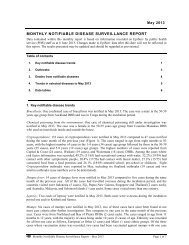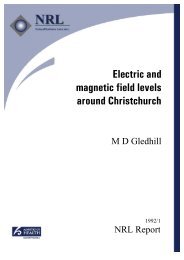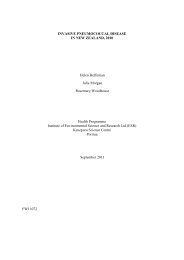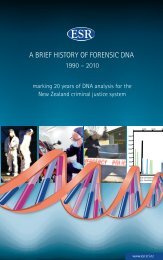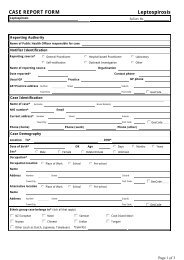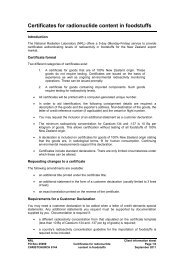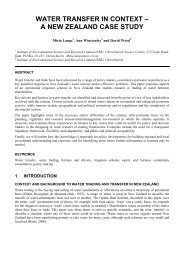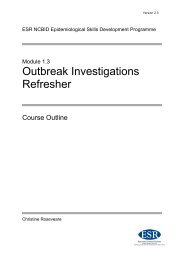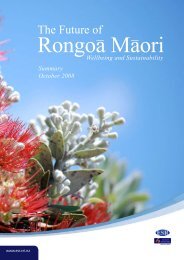environmental health indicators for new zealand: feasibility study
environmental health indicators for new zealand: feasibility study
environmental health indicators for new zealand: feasibility study
You also want an ePaper? Increase the reach of your titles
YUMPU automatically turns print PDFs into web optimized ePapers that Google loves.
5. DISCUSSION5.1 GeneralThe proposed WHO indicator set would provide a useful initial benchmark <strong>for</strong> NZinternationally and in so doing, a focus <strong>for</strong> the consolidation of data on <strong>environmental</strong>exposure, <strong>health</strong> outcome and public <strong>health</strong> action. It potentially provides a springboard <strong>for</strong>refining action on data collection, collation and analysis and making better evidence baseddecisions <strong>for</strong> public <strong>health</strong> locally, regionally and nationally.There already exists a wealth of data, collected at various levels in New Zealand to establishappropriate indicator sets <strong>for</strong> <strong>environmental</strong> <strong>health</strong>. There is little justification <strong>for</strong>establishing <strong>new</strong> monitoring systems. The ability of users to understand and apply EHI’sdepends on enhancing the process <strong>for</strong> their utilisation in decision making.The current analysis illustrates two main data gaps, in the areas of indoor air quality andnoise. There needs to be further discussion on whether these need further consideration withregard to the setting up of monitoring systems.The set of <strong>indicators</strong> discussed in this report are primarily developed <strong>for</strong> internationalbenchmarking and as such other <strong>indicators</strong> need to be developed to reflect the crown’sobligations under the Treaty of Waitangi, the cultural diversity of the country and otherunique <strong>health</strong> or <strong>environmental</strong> issues.Given the current focus and content of data collection systems locally and internationally, thecost of setting up <strong>new</strong> systems and other factors, issues raised in this document, be theydiffering constructs of <strong>health</strong>, such as Hauora, would best be explored as part of a number ofcase studies and subsequently reflected within a national framework.5.2 Data AvailabilityFor the total WHO set including both extended and core set, the data is available <strong>for</strong> 70% ofthe <strong>indicators</strong>. Data is available currently <strong>for</strong> 74% of the core WHO <strong>indicators</strong>, beingrespectively• 70% <strong>for</strong> environment <strong>indicators</strong>,• 82 % <strong>for</strong> <strong>health</strong> <strong>indicators</strong> and• 81% <strong>for</strong> action <strong>indicators</strong>.By topic area the relevant figures are:• air quality (85%),• indoor air quality (80%),• housing (60%),• traffic (100%),• noise (17%),• workplace (70%),• chemical emergencies (71%),Environmental Health Indicators 26 18 December 2003<strong>for</strong> New Zealand




